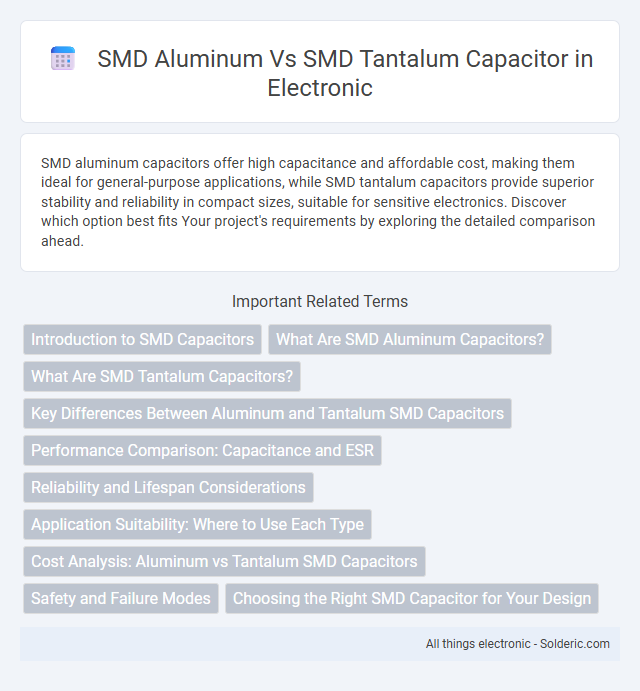SMD aluminum capacitors offer high capacitance and affordable cost, making them ideal for general-purpose applications, while SMD tantalum capacitors provide superior stability and reliability in compact sizes, suitable for sensitive electronics. Discover which option best fits Your project's requirements by exploring the detailed comparison ahead.
Comparison Table
| Feature | SMD Aluminum Capacitor | SMD Tantalum Capacitor |
|---|---|---|
| Dielectric Material | Aluminum oxide | Tantalum pentoxide |
| Capacitance Range | 0.1 uF to several mF | 0.1 uF to 470 uF |
| Voltage Range | 6.3 V to 450 V | 2.5 V to 50 V |
| Equivalent Series Resistance (ESR) | Higher ESR | Lower ESR |
| Reliability | Good, but less stable | High reliability, stable capacitance |
| Leakage Current | Higher leakage current | Low leakage current |
| Surge Tolerance | Higher surge tolerance | Lower surge tolerance |
| Cost | Lower cost | Higher cost |
| Applications | General purpose, power supply filtering | Precision circuits, low noise applications |
Introduction to SMD Capacitors
SMD aluminum capacitors offer high capacitance and voltage ratings with excellent ripple current handling, making them ideal for power supply filtering and decoupling applications. SMD tantalum capacitors provide stable capacitance, low ESR (Equivalent Series Resistance), and superior frequency response in a compact size, suited for space-constrained circuits requiring reliable performance. Both types are surface-mount technology (SMT) components widely used in modern electronics for efficient assembly and enhanced circuit density.
What Are SMD Aluminum Capacitors?
SMD aluminum capacitors are surface-mount devices featuring an aluminum electrolytic core, known for high capacitance values and cost efficiency in power supply filtering applications. They excel in smoothing voltage fluctuations and providing bulk energy storage, making them ideal for audio, power management, and decoupling circuits. Their construction offers robust performance in higher temperature ranges but typically lower frequency response compared to SMD tantalum capacitors.
What Are SMD Tantalum Capacitors?
SMD tantalum capacitors are surface-mount device components known for their high capacitance-to-volume ratio and stable electrical performance. They use tantalum metal as the anode material, providing excellent reliability, low equivalent series resistance (ESR), and enhanced capacitance stability over a wide temperature range. These capacitors are commonly used in applications requiring compact size, long-term durability, and low leakage current, such as in power supply filtering and signal processing circuits.
Key Differences Between Aluminum and Tantalum SMD Capacitors
SMD aluminum capacitors use an aluminum oxide layer as the dielectric, providing high capacitance values at lower cost but with larger physical sizes and lower volumetric efficiency compared to tantalum capacitors. SMD tantalum capacitors employ tantalum pentoxide dielectric, offering higher capacitance per volume, excellent stability, and lower equivalent series resistance (ESR), which makes them suitable for high-frequency applications and space-constrained designs. The key differences lie in their material composition, performance characteristics such as ESR and leakage current, and typical applications where durability and size constraints influence the choice between aluminum and tantalum SMD capacitors.
Performance Comparison: Capacitance and ESR
SMD aluminum capacitors typically offer higher capacitance values ranging from a few microfarads to several thousand microfarads, while SMD tantalum capacitors generally provide lower capacitance in the range of 0.1 to 100 microfarads. SMD tantalum capacitors excel with lower equivalent series resistance (ESR), often in the milliohm range, delivering better performance in high-frequency and low-ripple applications compared to aluminum types with higher ESR values. The lower ESR of tantalum capacitors results in improved efficiency and thermal stability, making them preferable in demanding electronic circuits despite their usually lower capacitance.
Reliability and Lifespan Considerations
SMD aluminum capacitors generally offer higher capacitance values but have a shorter lifespan and lower reliability under high-temperature conditions compared to SMD tantalum capacitors. SMD tantalum capacitors provide enhanced reliability and longer lifespan due to their stable dielectric material, making them ideal for critical applications requiring consistent performance. When choosing components for your design, prioritizing SMD tantalum capacitors can improve device durability and reduce failure rates in demanding environments.
Application Suitability: Where to Use Each Type
SMD aluminum capacitors are best suited for applications requiring high capacitance values, such as power supply filtering and bulk energy storage in consumer electronics. SMD tantalum capacitors excel in circuits demanding stable capacitance, low equivalent series resistance (ESR), and reliability, making them ideal for precision timing, audio, and aerospace applications. When selecting your capacitor, consider the device's voltage, capacitance needs, and thermal stability to ensure optimal performance.
Cost Analysis: Aluminum vs Tantalum SMD Capacitors
SMD aluminum capacitors typically offer a lower cost per unit compared to SMD tantalum capacitors, making them more economical for high-volume, cost-sensitive applications. The raw material and manufacturing processes for aluminum electrolytic capacitors are less expensive, resulting in a price advantage over tantalum capacitors, which use more costly tantalum powder and require tighter quality control. Despite higher initial costs, SMD tantalum capacitors provide better performance in terms of stability and size, potentially reducing overall system costs in specialized electronics.
Safety and Failure Modes
SMD aluminum capacitors typically feature a liquid electrolyte that can leak or cause swelling under thermal stress, posing safety risks such as short circuits or device damage. SMD tantalum capacitors utilize a solid electrolyte, which significantly reduces leakage but may experience catastrophic failure modes like igniting when exposed to surge currents or voltage spikes. The inherent material and construction differences dictate that aluminum capacitors fail gradually with visible deformation, whereas tantalum capacitors can fail abruptly, necessitating cautious voltage derating for improved safety.
Choosing the Right SMD Capacitor for Your Design
Choosing the right SMD capacitor for your design depends on factors like capacitance, voltage rating, ESR, and temperature stability. SMD aluminum capacitors offer high capacitance values and excellent ripple current handling, making them suitable for power supply filtering and bulk energy storage. In contrast, SMD tantalum capacitors provide superior volumetric efficiency, stable capacitance over temperature, and low ESR, ideal for high-frequency decoupling and space-constrained applications.
SMD aluminum vs SMD tantalum capacitor Infographic

 solderic.com
solderic.com